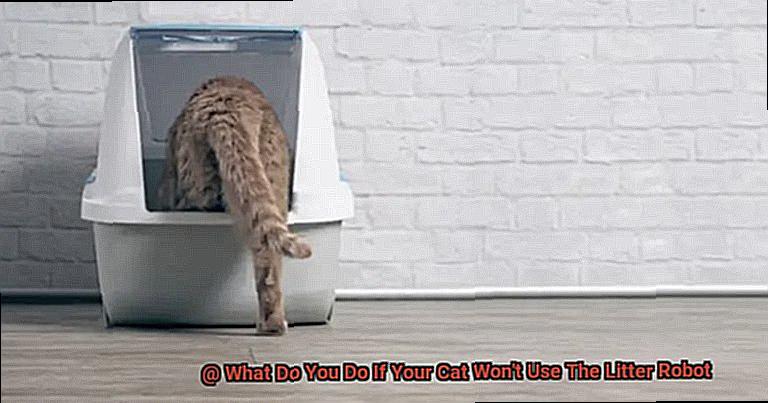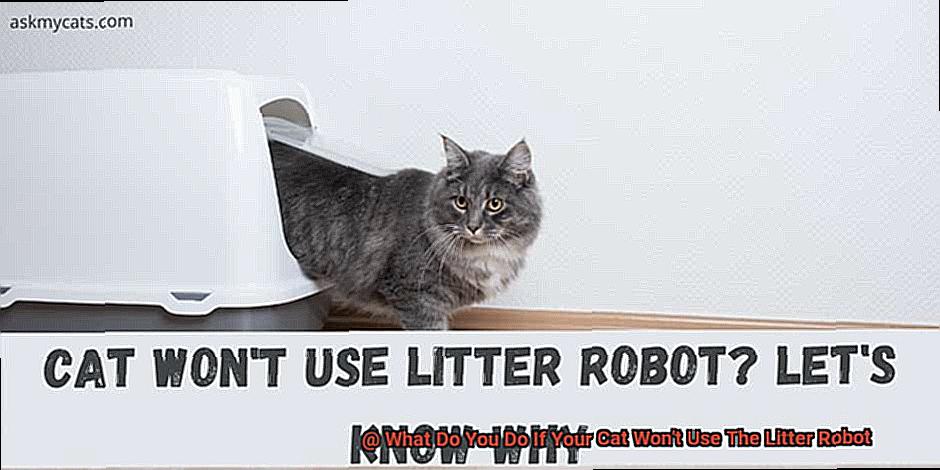Struggling to get your cat to use their new Litter Robot? Don’t worry – it’s a common problem. Cats are creatures of habit, and getting used to a new device can take time. But with patience and the right approach, you’ll soon have them happily using it.
First, find out why your cat is refusing to use the robot. They may be overwhelmed by its size or scared of its noise and movement. Place the robot in a familiar spot, disable any sound effects and give your cat plenty of time alone with it before gradually introducing them into it.
Don’t give up yet. With these tips, you can successfully train your cat on how to use their new gadget. Be patient with them – you’ll soon see results.
Check For Mechanical Issues and Make Sure the Litter Robot is Properly Set Up
To start, perform a thorough visual inspection of the unit and test it to ensure that it is working properly. Look for any signs of wear and tear or damage, such as cracks or loose parts. Make sure that the waste drawer opens and closes smoothly, and that the rotating globe moves without any issues.
Next, select an appropriate litter type for your cat – some cats prefer clumping litter while others prefer non-clumping or crystal litter. To make their transition easier, add a small amount of their old litter to the Litter Robot for a familiar scent.
Finally, place the Litter Robot in an area of your home where your cat will feel comfortable using it.
Cats prefer quiet, private areas for their litter box so consider placing it in an out-of-the-way corner.
Avoid placing it in noisy or high-traffic areas as this could make them hesitant to use it.

Place the Litter Robot in a Location Where Your Cat Usually Goes to the Bathroom
Introducing a Litter Robot to your cat can be a challenge, but with patience and the right approach, you can convince them to try it out.
First, make sure the litter robot is properly set up and that there are no mechanical issues. Check the litter level and ensure there is ample space around the unit for your cat to enter and exit comfortably.
Additionally, try to position the Litter Robot away from any noisy appliances that may startle your pet.
Most importantly, place the Litter Robot in a location where your cat usually goes to the bathroom. Cats are creatures of habit and need consistency when it comes to their bathroom habits. Start by placing the Litter Robot next to their existing litter box then gradually move it closer to where you want it to be.
Make the Litter Robot appealing by placing treats or toys inside or near it so that your cat begins associating it with positive things.
You may also try using a litter that closely mimics the one your cat uses in their regular litter box.
Continue monitoring your cat’s behavior and adjust accordingly until they become familiar with their new automated litter box.
Transition Your Cat Slowly to the Litter Robot
Transitioning your cat to the Litter Robot can be a challenge, but with the right steps, you can make the process much easier for both you and your furry friend.
Start by placing the Litter Robot in a quiet, low-traffic area of your home. Cats prefer privacy when using the litter box, so it’s important to give them a space that feels safe and secure. Avoid placing it near appliances that may make loud noises.
Next, introduce your cat to the Litter Robot slowly. Some cats may need more time than others to adjust to a new litter box. Start by placing the Litter Robot next to their current litter box and let them observe it for a few days before transitioning them over. To help them associate the new box with their scent, place some of their used litter in the new box.

Keep an eye on your cat as they adapt to their new litter box. If they seem hesitant, try encouraging them with treats or toys. You can also place their favorite blanket or toy near the box to make it more inviting.
If your cat still refuses to use the Litter Robot, try switching back to their old litter box temporarily and then gradually re-introducing the Litter Robot again. It may take some time and patience, but most cats eventually adapt to this new convenience and begin using it without issue.
Remember to clean and maintain the Litter Robot regularly for optimal results.
Cats are clean animals and may be put off by an unclean environment, so scoop solids daily, empty the waste drawer as needed, and thoroughly clean the unit every few weeks for best results.
Make the Litter Robot Appealing To Your Cat
Begin by introducing it gradually. Place the Litter Robot next to your cat’s regular litter box and let them explore it at their own pace. Once they seem comfortable, slowly move it closer to its permanent position. It’s also essential to use the same litter that your cat is used to – if you change it, they may avoid using the Litter Robot altogether.
Second, keep it clean. Cats are very particular about hygiene and won’t use a litter box that isn’t spotless. To ensure optimal sanitation, empty and clean the waste drawer frequently.

Third, make it fun. Cats love to play and explore new things, so turn the Litter Robot into an exciting place for them by placing toys or treats near it. This way, they will associate good things with their new robot companion and be more likely to use it.
Finally, give it time. Some cats may take longer than others to adjust to their new litter box, so be patient and give them time to get used to it.
Try Different Types of Automatic Litter Boxes or Stick With a Traditional Litter Box
When it comes to litter boxes, there are plenty of options available to suit your feline friend. If your cat is not using the Litter Robot, you may want to consider trying out different types of automatic litter boxes or sticking with a traditional litter box.
Automatic litter boxes come with a range of features and advantages, such as self-cleaning mechanisms, reduced odors, and less manual labor for the cat owner. However, transitioning your cat from its old litter box to a new one slowly is essential, especially if it’s an automatic one with a different mechanism.
If that’s the case, you can try an alternate type of automatic litter box that makes less noise or has a different latch. Some cats may prefer a covered litter box which provides them with more privacy and security.
On the other hand, traditional litter boxes are usually more affordable and straightforward, with no complex mechanisms or features. If your cat is not using the Litter Robot, you can switch back to a traditional litter box and see if that solves the issue.
To keep the area inviting for your furry friend, make sure to clean the litter box regularly and replace the litter often.
Monitor Your Cat’s Behavior and Adjust Accordingly
There are plenty of other automatic litter boxes out there that may suit their needs. But before you switch, it’s important to pay attention to your cat’s behavior and make the necessary adjustments.
Start by monitoring how often they are using the litter box. If they’re not going as frequently as usual, it could be a sign that they are avoiding the robot. In this case, providing extra litter boxes around the house as a temporary solution while still encouraging them to use the robot is a good idea.
Take into account your cat’s preference for litter too. Some cats may be pickier than others and may not like the type of litter used in the robot. To find one that your cat loves, experiment with different types of litter until you find one that works best for them.
If needed, make adjustments to the litter robot itself as well. If your cat is hesitant to go in, try leaving the lid open for a few weeks so they can get used to it.
If they’re scared of the noise or movement of the robot, try turning off the automatic cycle feature and manually emptying the waste drawer until they feel more comfortable.
Consider Using a Different Type of Automatic Litter Box
If your cat won’t use the Litter Robot, don’t worry – there are plenty of other options available. Automatic litter boxes come in a variety of shapes and sizes, each with its own unique features and benefits.
For those looking for a quiet and energy-efficient option, the PetSafe Simply Clean Automatic Litter Box is an excellent choice. This litter box uses a conveyor belt system to continuously remove waste and keep the litter fresh. It’s also incredibly low-maintenance and easy to clean.
On the other hand, if you’re looking for something more advanced, the CatGenie Self-Washing Self-Flushing Cat Box might be right up your alley. This litter box actually washes and dries the granules of litter, meaning you don’t have to use traditional litter at all. Plus, it’s very simple to maintain.
No matter which automatic litter box you choose, it’s important to introduce it slowly and positively to your cat.
Some cats may be hesitant to use a new litter box, so take your time and make sure your cat is comfortable with their new environment before attempting to use it.
IQFVcqjEqtw” >
Conclusion
When your cat won’t use their new Litter Robot, it can be a frustrating experience. But with a little patience and the right approach, you can help them make the switch.
Start by setting up your robot correctly and using a litter that your cat is familiar with. Place it in an area of the house where they feel comfortable and secure, and reward them with treats or toys for using it.
If needed, you can always try switching to a different style of automatic litter box or sticking with a traditional one.
Most importantly, give your cat time to adjust to their new one. Cats are creatures of habit and need consistency in their toilet habits, so be patient and understanding as they get used to their new automated litter box.







